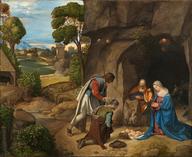Subject

photo credits: Wikimedia Commons
The nativity of Jesus, nativity of Christ, birth of Jesus or birth of Christ is documented in the biblical gospels of Luke and Matthew. The two accounts agree that Jesus was born in Bethlehem, Judaea, that his mother, Mary, was engaged to a man named Joseph, who was descended from King David and was not his biological father, and that his birth was caused by divine intervention. Many modern scholars consider the birth narratives unhistorical because they are laced with theology and present two different accounts which cannot be harmonised into a single coherent narrative. Some view the question of historicity as secondary, given that gospels were primarily written as theological documents rather than chronological timelines. The nativity is the basis for the Christian holiday of Christmas and plays a major role in the Christian liturgical year. Many Christians traditionally display small manger scenes depicting the nativity within or outside of their homes, or attend nativity plays or Christmas pageants focusing on the nativity cycle in the Bible. Elaborate nativity displays featuring life-sized statues are a tradition in many continental European countries during the Christmas season. The artistic depiction of the nativity has been an important subject for Christian artists since the 4th century. Artistic depictions of the nativity scene since the 13th century have emphasized the humility of Jesus and promoted a more tender image of him, a major change from the early "Lord and Master" image, mirroring changes in the common approaches taken by Christian pastoral ministry during the same era. Source: Wikipedia (en)
Works about Nativity of Jesus 2
Works based on Nativity of Jesus 19
 Advent and Triumph of Christ
Advent and Triumph of Christ The Mystical Nativity
The Mystical Nativity Nativity with St. Francis and St. Lawrence
Nativity with St. Francis and St. Lawrence- Triptych of Nava and Grimon
 Nativity
Nativity Nativity of Christ with angels
Nativity of Christ with angels The Nativity
The Nativity Nativity of Christ
Nativity of Christ Adoration of the Shepherds
Adoration of the Shepherds Nativity of Christ
Nativity of Christ Nativity of Christ
Nativity of Christ Nativity
Nativity The Nativity with the Prophets Isaiah and Ezekiel
The Nativity with the Prophets Isaiah and Ezekiel Annunciation
Annunciation- Triptych of birth of Christ
 Life of Christ
Life of Christ Birth of Christ
Birth of Christ Nativity
Nativity Nativité
Nativité
Subject - wd:Q51628